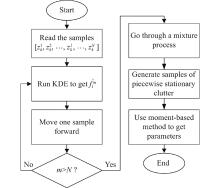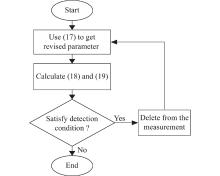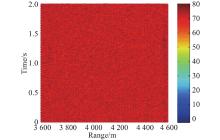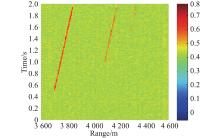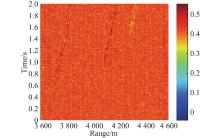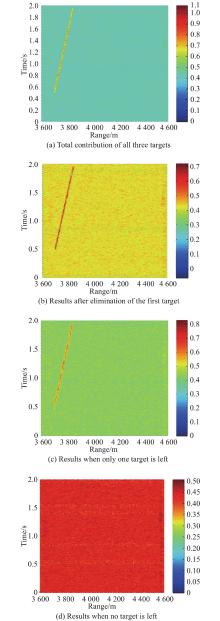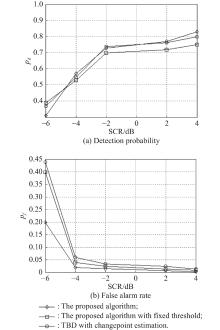| 1 |
ROSENBERG L, VENKATARAMAN K, JENKE C. Target detection in medium grazing angle sea clutter using scan to scan processing. Proc of the International Radar Conference, 2019. DOI: 10.1109/RADARA1533.2019.171341.
|
| 2 |
ZHANG Y S, WANG W G, WANG N, et al A knowledge-aided wald detector for target detection in sea clutter. Proc. of the International Conference on Control, Automation and Information Sciences, 2019, 1- 4.
|
| 3 |
CHEN S C, LUO F, LUO X X Multiview feature-based sea surface small target detection in short observation time. IEEE Geoscience and Remote Sensing Letters, 2020, 1- 5.
|
| 4 |
ROSENBERG L, DUK V, NG B Detection in sea clutter using sparse signal separation. IEEE Trans. on Aerospace and Electronic Systems, 2020, 1- 11.
|
| 5 |
ZAIMBASHI A, DERAKHTIAN M, SHEIKHI A Invariant target detection in multiband FM-based passive bistatic radar. IEEE Trans. on Aerospace and Electronic Systems, 2014, 50 (1): 720- 736.
doi: 10.1109/TAES.2013.120248
|
| 6 |
ZAIMBASHI A Forward M-ary hypothesis testing based detection approach for passive radar. IEEE Trans. on Signal Processing, 2017, 65 (10): 2659- 2671.
doi: 10.1109/TSP.2017.2666778
|
| 7 |
SOLATZADEH Z, ZAIMBASHI A Accelerating target detection in passive radar sensors: delay-doppler-acceleration estimation. IEEE Sensors Journal, 2018, 18 (13): 5445- 5454.
doi: 10.1109/JSEN.2018.2837096
|
| 8 |
BOLVARDI H, DERAKHTIAN M, SHEIKHI A Dynamic clutter suppression and multitarget detection in a DVB-T-based passive radar. IEEE Trans. on Aerospace and Electronic Systems, 2017, 53 (4): 1812- 1825.
doi: 10.1109/TAES.2017.2674138
|
| 9 |
SANTI F, PASTINA D Application of track-before-detect techniques in GNSS-based passive radar for maritime surveillance. Proc. of the IEEE Radar Conference, 2019, 1- 6.
|
| 10 |
GUERRAOU Z, KHENCHAF A, COMBLET F, et al Particle filter track-before-detect for target detection and tracking from marine radar data. Proc. of the IEEE Conference on Antenna Measurements & Applications, 2019, 1- 4.
|
| 11 |
RISTIC B, ROSENBERG L, KIM D Y, et al Bernoulli track-before-detect filter for maritime radar. IET Radar, Sonar & Navigation, 2020, 14 (3): 356- 363.
|
| 12 |
KIM D Y, RISTIC B, WANG X, et al. A comparative study of track-before-detect algorithms in radar sea clutter. Proc. of the International Radar Conference, 2019. DOI: 10.1109/RADAR41533.2019.171306.
|
| 13 |
RISTIC B, ROSENBERG L, KIM D Y, et al. Benourlli filter for track-before-detect: swerling-1 target inK-distributed clutter. Proc. of the International Radar Conference, 2019. DOI: 10.1109/RADAR41533.2019.171217.
|
| 14 |
RISTIC B, KIM D Y, ROSENBERG L, et al Bernoulli multi-target track-before-detect for maritime radar. Proc. of the IEEE International Radar Conference, 2020, 878- 883.
|
| 15 |
BERRY P, VENKATARAMAN K, ROSENBERG L Adaptive detection of low-observable targets in correlated sea clutter using Bayesian track-before-detect. Proc. of the IEEE Radar Conference, 2017, 0398- 0403.
|
| 16 |
STONE D L, STREIT R L, CORWIN T L. Bayesian multiple target tracking. London: Artech House, 2014.
|
| 17 |
BREKKE E, KIRUBARAJAN T, THARMARASA R Tracking dim targets using integrated clutter estimation. Proceedings of the SPIE, 2007, 6699, 669905.
doi: 10.1117/12.734296
|
| 18 |
NORTHROP J A, PAPANDREOU-SUPPAPPOLA A. Computationally efficient estimation of compound K-distribution sea clutter in thermal noise and its application to sea echo reflectivity observations. IEEE Trans. on Aerospace and Electronic Systems, 2020, 56(3): 2340–2350.
|
| 19 |
CHEN X, THARMARASA R, PELLETIER M, et al Integrated bayesian clutter estimation with JIPDA/MHT trackers. IEEE Trans. on Aerospace and Electronic Systems, 2013, 49 (1): 395- 414.
doi: 10.1109/TAES.2013.6404111
|
| 20 |
MAJDARA A, NOOSHABADI S Nonparametric density estimation using copula transform, Bayesian sequential partitioning, and diffusion-based kernel estimator. IEEE Trans. on Knowledge and Data Engineering, 2020, 32 (4): 821- 826.
doi: 10.1109/TKDE.2019.2930052
|
| 21 |
BOTEV Z I, GROTOWSKI J F, KROESE D P Kernel density estimation via diffusion. The Annals of Statistics, 2010, 38 (5): 2916- 2957.
|
| 22 |
GOKCESU K, KOZAT S S Online anomaly detection with minimax optimal density estimation in nonstationary environments. IEEE Trans. on Signal Processing, 2018, 66 (5): 1213- 1227.
doi: 10.1109/TSP.2017.2784390
|
| 23 |
LIU N B, DONG Y L, WANG G Q, et al Sea-detecting X-band radar and data acquisition program. Journal of Radars, 2019, 8 (5): 656- 667.
|
 ), Zishu HE1(
), Zishu HE1( ), Haicheng LIU2(
), Haicheng LIU2( ), Yadan LI3(
), Yadan LI3( )
)
